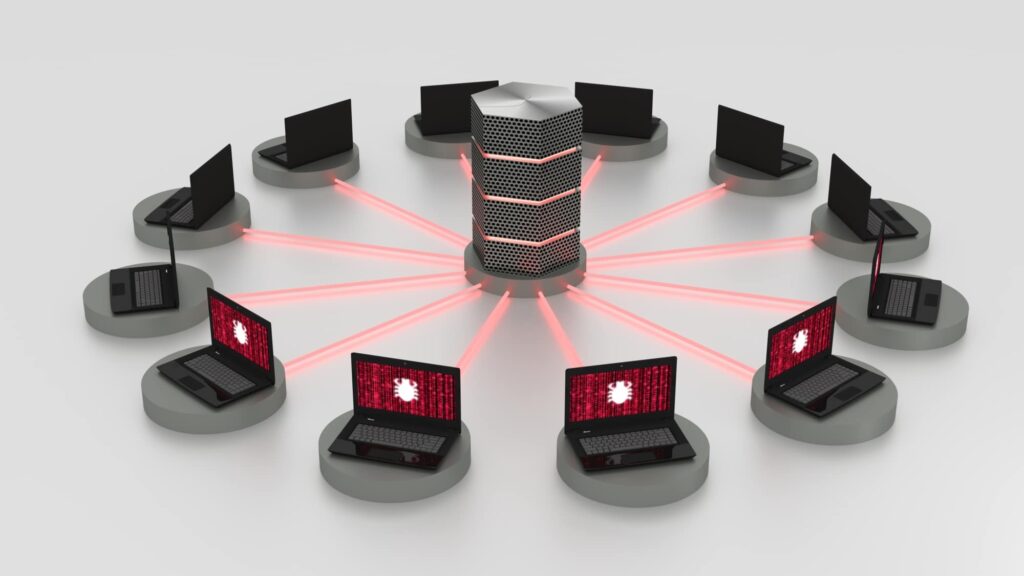The Cyber Mafia: How Hackers Run Multi-Billion Dollar Enterprises Better Than You

By Isaac Osei Alvaro – Cybersecurity Expert and Strategist
Welcome to the Criminal C-Suite
Welcome to the digital age—an era where some of the most sophisticated, profitable, and well-run enterprises in the world operate entirely outside the bounds of legality.
Let’s be honest with ourselves. The image of a lone hacker in a dark hoodie, tapping away in a basement, is dangerously outdated. Today’s cybercriminals are not misfits poking at firewalls for fun—they’re digital kingpins running enterprises that rival, and often surpass, their legitimate counterparts in structure, agility, and results.
They have:
- CEOs and executive boards
- Departmental heads and KPIs
- Affiliate programs and service-level agreements
- Quarterly revenue goals, and yes—even performance reviews
Cybercrime is no longer a technical nuisance. It’s a thriving global business model. The uncomfortable truth? These illegal operations are outpacing many legitimate businesses in innovation, execution, and ROI.

The Corporate Structure of Cybercrime
Let’s reverse-engineer the underworld.
Just like your organization has departments—sales, development, customer service—so do criminal syndicates. Except in their world, speed trumps compliance, and innovation isn’t slowed down by board meetings or bureaucracy.
Ransomware-as-a-Service: The Franchise Model
Ransomware-as-a-Service (RaaS) has become the McDonald’s of cybercrime. One core team develops malicious software, then “licenses” it to affiliates around the world who execute the attacks. The affiliates do the dirty work—targeting victims, deploying the malware, negotiating ransoms—while the developers take a percentage cut of the profits.
It’s Software-as-a-Service (SaaS), just flipped on its head. The business logic is the same: scalable, low-overhead, subscription-based revenue.
Phishing: The Cybercriminal Sales Funnel
Phishing isn’t a spray-and-pray tactic. It’s a refined sales operation.
There’s a content team crafting psychologically persuasive emails. A marketing team that runs distribution—often using botnets or hijacked email servers. A conversion team handles what’s stolen: login credentials, identity data, financial access. These are passed on or sold through dark web marketplaces in a structured pipeline.
They run A/B tests. They monitor open rates. They tweak subject lines. Sound familiar?
Zero-Day Exploits: Underground R&D
Imagine a world-class researcher discovering a security flaw that no one else knows about. In the legitimate world, they might report it to the vendor or a bug bounty program for a few thousand dollars.
In the underground market? That same vulnerability could sell for millions, particularly if it enables remote code execution on a widely used platform. These researchers don’t wear lab coats. But make no mistake—they are among the best technical minds in the world.


And they’re not working for you.
The Cybercrime Supply Chain
Cybercrime is not a single actor pulling off a heist—it’s a supply chain. Each link in the chain represents a specialized role, often handled by different criminal groups working in tandem.
- Initial Access Brokers specialize in breaching systems. They gain entry—often through phishing, credential stuffing, or exposed RDP ports—and sell that access to others for use in ransomware or espionage.
- Exploit Developers create the technical tools. Think of them as your product engineers—building ransomware kits, spyware, information stealers, or keyloggers.
- Money Launderers handle revenue processing. They convert ransom payments into clean money via mixers, crypto tumblers, mules, and fake shell corporations. Offshore networks and anonymity-enhancing tools make their “finance” department nearly invisible.
Each group may not even know who the others are. They interact via aliases and encrypted channels. But the coordination and efficiency rival that of a modern logistics firm.
Why Cybercrime Thrives
What makes cybercriminals so effective? Three powerful advantages.
1. No Regulation, No Red Tape
They don’t care about GDPR, HIPAA, or SOC 2 compliance. They don’t need procurement forms, vendor reviews, or legal sign-off. While your team schedules three meetings to approve a patch, they’ve already scanned for vulnerabilities, exploited them, and monetized the breach.
Speed is their secret weapon. Agility is their culture.
2. A Borderless Talent Pool
Cybersecurity professionals are in short supply, and good ones are expensive. Companies demand certifications, degrees, clean backgrounds. Criminals don’t.
If you can deliver results, you’re in. No CV required. No interviews. A self-taught coder in Lagos, a former pentester in Berlin with a criminal record, a math prodigy in Kiev—they all find work in this underground economy.
And yes, they pay very well.
3. Low Risk, Massive Reward
A bank robber risks getting shot or imprisoned. A ransomware attacker, on the other hand, could steal millions without ever being physically present. If they’re careful, they’re untraceable.
Cybercrime is asymmetric warfare. A small team with laptops can extract more value than a traditional crime syndicate ever could—at a fraction of the risk.

What This Means for You
If these criminal enterprises are more efficient than your business, you have a serious problem. It means you’re competing against an enemy with more agility, fewer constraints, and possibly more talent.
And whether you like it or not, you are competing. Every time you hold off on a security update, delay a cybersecurity training, or skip an audit, you give them the edge.
Reframe the Problem
Stop treating cybercrime as a purely technical issue. It’s economic. Strategic. Organizational. Your attackers are running their business like professionals—are you?
Accelerate Your Defenses
- Speed matters. If your incident response takes weeks, you’ve already lost. Your team should be agile, empowered, and practiced.
- Train relentlessly. 90% of breaches involve human error. Phishing, weak passwords, careless clicks. Awareness isn’t optional—it’s armor.
- Segment your network. Don’t give attackers the digital equivalent of an open floor plan. If they get in, they should hit a dead end quickly.
- Invest like it matters. Security isn’t a cost—it’s survival infrastructure. Don’t underfund it.
Ditch the “Not Me” Mindset
You don’t have to be a Fortune 500 company to get attacked. Small businesses are prime targets because they’re often poorly protected. Hospitals, nonprofits, startups, municipalities—if you have data, credentials, or money, you’re fair game.


The Final Thought
Ask yourself this: How many meetings, approvals, and committees does it take for your company to deploy a single security update?
Now compare that to a cybercrime syndicate:
- New exploit discovered Monday
- Campaign crafted by Tuesday
- Launched and scaled globally by Wednesday
They test, iterate, and scale faster than you can approve a software license.
They’re outpacing your business not just in cyberattacks, but in business execution.
The question isn’t whether your organization will be attacked. It’s whether you’re prepared to defend against an adversary who runs a criminal enterprise with more focus, efficiency, and innovation than you run your legal one.
Because right now?
They’re not just beating you.
They’re outperforming you.










su kaçak bulma İstanbul Aile Dostu Hizmet: Evde çocuklar olduğu için hızlı ve sessiz çalıştılar, teşekkür ederiz. https://www.bosphoruscymbals.com/uskudar-tesisatci/
İçerenköy su kaçak tespiti Beşiktaş Kuruçeşme’deki su kaçağını doğru tespit ettiler. Gerçekten harika bir ekip! https://www.bosphoruscymbals.com/uskudar-tesisatci/
İzzetpaşa su kaçak tespiti Altunizade su kaçağı tespiti: Altunizade’de su kaçağı için profesyonel destek. https://www.provolutions.com/?p=4441
Hüseyinli su kaçak tespiti Bulgurlu su kaçağı tespiti: Bulgurlu’da su kaçağına anında müdahale. http://gruposiia.com.mx/?p=24592
Etiler su kaçağı tespiti Cihangir su kaçağı tespiti: Cihangir’deki su kaçaklarına noktasal çözüm sunuyoruz. https://aaim.co.in/?p=69811
Etiler su kaçak tespiti Balkondaki su kaçağını bulmak için gelen ekip çok deneyimliydi. Sorunu kalıcı olarak çözdüler. Cemil W. http://mythicsky.com/?p=1988
Gültepe su kaçak tespiti Banyo duvarındaki nem için çağırdığımız ekip çok profesyoneldi. Kaçağın yerini hızlıca tespit ettiler. Volkan X. http://sat.poznan.pl/?p=2550
Yenimahalle su kaçak tespiti Tuvaletteki gizli kaçağı termal kamerayla hemen buldular. İşlerini çok temiz yaptılar, hiç dağınıklık olmadı. Kemal A. https://www.alabamalighthouses.com/?p=23136
Çekmeköy su kaçak tespiti Hızlı Ekip: Kocaman bir ekiple geldiler ve işlemi çok hızlı tamamladılar. https://onsetinfotech.com/author/kacak/
Very insightful and well-written. I learned a lot from this! Pls check my website: https://emopat.xyz/ !
Your blog is a beacon of light in the often murky waters of online content. Your thoughtful analysis and insightful commentary never fail to leave a lasting impression. Keep up the amazing work!
Şişli su kaçağı tespiti Beylikdüzü’ndeki evimizdeki su kaçağını bulmaları çok zordu, ama çok başarılı oldular. https://divinedirectory.com/author/kacak/
Maslak su kaçağı tespiti İşyerindeki Kaçağı Çözdüler: Ofiste su kaçağı vardı. Hızlı bir şekilde tespit edip tamir ettiler. https://guard-xpress.com/author/kacak/
Silivri su kaçağı tespiti Profesyonel ekipmanlar, insan kulağının alamayacağı sesleri tespit edebilir. https://theatreintangible.com/author/kacak/
Just wanna tell that this is invaluable, Thanks for taking your time to write this.
It’s inspiring to see officials taking active steps in monitoring and guiding local development projects. Such proactive leadership ensures transparency and progress at the grassroots level. Speaking of progress, platforms like Laser Book 247 are also redefining how people experience sports interaction online. With smooth navigation, real-time updates, and a wide array of sporting experiences, Laser Book 247 is becoming a go-to platform for those who enjoy staying connected with their favorite sports in a modern way. Just as developmental inspections ensure growth in our towns, platforms like this ensure advancement in digital engagement.
Laser Book 247 stands out as a top platform for playing Play Teen Patti Online with Real Money on Laser Book 247 with real money, thanks to its rich features and player-centric benefits. The platform provides multiple Teen Patti variations, real-time gaming, and round-the-clock tables so you’re never short of action. Whether you’re playing for fun or aiming for big wins, the secure payment system and instant withdrawals make every session rewarding. From smooth gameplay to strong community features, Laser Book 247 focuses on making your experience both fun and financially exciting. With bonuses and regular promotions, your chances of earning while enjoying are higher than ever.
Bağcılar su kaçağı tespiti Şişli su kaçağı tespiti: Şişli bölgesinde güvenilir su kaçağı tespit hizmetleri. http://banahkhabar.com/author/kacak/
Hadımköy su kaçak tespiti Pratik Çözüm: Tesisat sorunlarına pratik çözümler sundular. https://ideasofdecoration.com/index.php/author/kacak/
Maltepe su kaçağı tespiti İşlerini hızlı ve temiz yaptılar, çok memnun kaldım. https://aipair.io/read-blog/5005
Menderes su kaçak tespiti Binamızdaki su kaçağını tespit etmek için kullandıkları teknoloji son derece gelişmişti. Sorunu kısa sürede çözdüler. Cengiz V. https://leicestercityfansclub.com/read-blog/11645
Gaziosmanpaşa su kaçağı tespiti Ekip çok kibar ve işini iyi yapıyor, teşekkürler! https://carolinahurricanesclub.com/read-blog/5577
kırmadan dökmeden su kaçak tespiti Levent su kaçağı tespiti: Levent’te su kaçağını en hızlı ve doğru şekilde tespit ediyoruz. https://www.flexsocialbox.com/read-blog/38158
Kestanelik su kaçak tespiti Bu kadar hassas tespit yapan bir firma daha önce görmemiştim. https://leicestercityfansclub.com/read-blog/11645
İstanbul su tesisat kaçağı tespiti Alibeyköy su kaçağı tespiti: Alibeyköy’de su kaçağına kesin çözüm için bizimle iletişime geçin. https://communiti.pcen.org/read-blog/28282
Florya su kaçak tespiti Mutfak tezgahının altındaki su kaçağını tespit etmek için geldiklerinde çok titiz davrandılar. Fayanslarıma zarar vermeden sorunu çözdüler. Mehmet S. https://soocian.com/read-blog/24813
Fatih su kaçağı tespiti Bağcılar su kaçağı tespiti: Bağcılar’daki su kaçağı sorunlarına çözüm sunuyoruz. https://socialsmerch.com/read-blog/24063
Bağcılar su kaçak tespiti Bilinçlendirme: Su kaçağı sorunları hakkında bizi bilinçlendirdiler. https://bence.net/read-blog/25188
A lot of thanks for your entire effort on this web page. Betty really loves participating in investigations and it is simple to grasp why. My partner and i notice all regarding the compelling ways you provide advantageous solutions via the web site and as well attract participation from other ones about this article and my princess is without question studying a lot. Take pleasure in the rest of the new year. You’re the one doing a very good job.
su kaçağı tespiti Pratik Çözüm: Tesisat sorunlarına pratik çözümler sundular. http://woorichat.com/read-blog/41060
Hamidiye su kaçak tespiti Düzenli kontroller, sürprizleri engeller. https://www.bondhuplus.com/read-blog/190840
Sancaktepe su kaçağı tespiti Modern Ekipmanlar: Eskiden kırarak tespit yapılırdı, artık bu cihazlarla çok daha kolay. https://onmybet.com/read-blog/25971
fabuloso este conteúdo. Gostei bastante. Aproveitem e vejam este site. informações, novidades e muito mais. Não deixem de acessar para se informar mais. Obrigado a todos e até a próxima. 🙂
Everything is very open and very clear explanation of issues. was truly information. Your website is very useful. Thanks for sharing.
brkyk5
Heya this is kind of of off topic but I was wanting to know if blogs use WYSIWYG editors or if
you have to manually code with HTML. I’m starting a blog soon but have no coding expertise so I wanted to get guidance
from someone with experience. Any help would be greatly appreciated!
Here is my page – Metabolism Booster Pills
Wow! Thank you! I continuously wanted to write on my site something like that. Can I implement a fragment of your post to my website?
I have been absent for a while, but now I remember why I used to love this site. Thank you, I’ll try and check back more frequently. How frequently you update your site?
Howdy! Quick question that’s totally off topic. Do you know how to make your site mobile friendly? My website looks weird when browsing from my iphone. I’m trying to find a template or plugin that might be able to correct this problem. If you have any suggestions, please share. Thanks!
hgh dosage iu
References:
4 iu hgh per day results
I simply couldn’t leave your site before suggesting that I extremely loved the standard info a person provide in your visitors? Is gonna be back continuously in order to check out new posts
Nice blog here! Also your site loads up very fast! What host are you using? Can I get your affiliate link to your host? I wish my website loaded up as quickly as yours lol
very good post, i certainly love this website, keep on it
dianabol first cycle
References:
dianabol Only Cycle Results
Hello, I think your website might be having browser compatibility issues. When I look at your website in Safari, it looks fine but when opening in Internet Explorer, it has some overlapping. I just wanted to give you a quick heads up! Other then that, awesome blog!
When I originally commented I clicked the -Notify me when new comments are added- checkbox and now each time a comment is added I get four emails with the same comment. Is there any way you can remove me from that service? Thanks!
hgh dosage iu
References:
hgh morgens oder abends (carrieresecurite.fr)
best steroid cycle for beginner
References:
biggest muscles without steroids [https://motionentrance.edu.np]
best beginner steroid cycle
References:
Valley.Md
negative effect definition
References:
Anabolic Prescription, Git.Edazone.Cn,
Definitely believe that which you said. Your favorite justification seemed to be on the net the simplest thing to be aware of. I say to you, I definitely get annoyed while people think about worries that they just don’t know about. You managed to hit the nail upon the top as well as defined out the whole thing without having side effect , people could take a signal. Will likely be back to get more. Thanks
Bespoke cleaning professionals, personalized service delivery. Tailored service excellence. Custom satisfaction.
Those are yours alright! . We at least need to get these people stealing images to start blogging! They probably just did a image search and grabbed them. They look good though!
Dry Cleaning in New York city by Sparkly Maid NYC
Whats up very nice site!! Guy .. Beautiful .. Amazing .. I’ll bookmark your website and take the feeds also?KI am glad to search out a lot of helpful information right here within the post, we’d like develop more strategies in this regard, thanks for sharing. . . . . .
cjc 1295 ipamorelin sublingual
References:
how much ipamorelin should I take – https://www.google.dm/ –
cjc 1295 ipamorelin dosage
References:
peg-mg Ipamorelin and sermorelin series dosage
cjc 1295 ipamorelin vs igf-1 lr3
References:
excretion of ipamorelin (tippy-t.com)
cjc-1295/ipamorelin 5/5mg
References:
does ipamorelin make you tired – ezproxy.cityu.edu.Hk –
injecting ipamorelin
References:
how to reconstitute 5mg of ipamorelin (http://www.liberte-de-conscience-rideuromed.org)
tesamorelin cjc ipamorelin
References:
who sells the highest quality peptides ipamorelin cjc 1295
cjc 1295 ipamorelin buy online
References:
Tesamorelin cjc 1295 ipamorelin
what does cjc ipamorelin do
References:
Ipamorelin 5mg dosage; dreamyourjobs.com,
cjc and ipamorelin peptide
References:
cjc-1295 ipamorelin benefits (thelyvora.com)
when to take cjc 1295 and ipamorelin
References:
hcg and ipamorelin
ipamorelin insulin sensitivity
References:
oral ipamorelin peptide (Phyllis)
comprare ipamorelin in italia
References:
Ipamorelin Nasal spray dose
I cling on to listening to the newscast speak about getting boundless online grant applications so I have been looking around for the top site to get one. Could you tell me please, where could i acquire some?